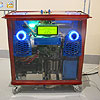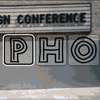 Originally
published
on
08/05/03
Originally
published
on
08/05/03"LowFlows" (a series of low-fi movies made specifically for low bandwidth distribution on the internet and designed for users to view at full screen) is a work by Peter Mertens that's available on "playingfield, a new environment for media players."
Not only are these works quite impressive--visually, aurally and technically--but they change each day according to "varying factors found on the web," therefore, truly earning their distinction as net art. The work is worth looking at for the abstract nature of the movies alone, but don't overlook the standalone application made in Max/Jitter, which you can download and use to mix your own versions of the movies to yours heart's delight!
:: Garrett Lynch ::
 Originally
published
on
08/04/03
Originally
published
on
08/04/03Dian Network is currently featuring Geoffrey Thomas's Storybeat. Thomas describes his work as a "house [of] experiments in animation, interaction and storytelling. In my work, I explore personal and psychological narratives. These explorations are often filtered through the culture of technology and influenced by the destabilizing elements of digital media. Using the web as my distribution platform, I am interested in experimenting with nonlinear and nonhierarchical structures, chance juxtapositions and responsive interaction."
Storybeat offers a complex web of interactive interfaces with no specific beginning or end. Some consist of simple mouseovers, while others offer intricate narratives with a certain "film-noir" style. A sense of incompletion is ever-present in all of the installments, and one always leaves the web project wondering if all of the elements were experienced. Storybeat's dependency on links as a way to tell stories is also used with an unusual approach that could only be possible with the latest available Flash and Shockwave technology.
Storybeat becomes most interesting when the users surf at random. The way the website is set up almost guarantees different narratives, depending on the links the users decide to click on during their respective visits. The first link for one user may be the third installment for another, and the last segment for yet another surfer. The end result is a decentralized non-linear presentation of dramatic moments that become abstracted while offering an intellectual tension between linear and non-linear storytelling. Modularity has influenced the way stories are being told, and Storybeat is a good example of how creative minds can make compelling work without presenting a neatly packaged story-line. It is the questions that drive us, and Storybeat is a nice set of possibilities.
:: Eduardo Navas ::
 Originally
published
on
08/01/03
Originally
published
on
08/01/03Aggregating Data : The web's favourite colour and How do you feel ?.
In a quest to find the web's favourite colour, Matt Webb asks visitors to send a photo of their favourite colour by MMS or email. Received images are abstracted and the average colour is then mixed with the others to find the web's current favourite, which is revealed as the page background. Dellbrugge & de Moll's How do you feel ? asks exactly that, inviting visitors to contribute their current disposition to the world wide mood, the results of which can be viewed for that day or as a statistical graph for the year.
:: Neil Jenkins ::
 Originally
published
on
08/01/03
Originally
published
on
08/01/03Blogs have been around for a relatively short time. Net Art Review runs one of them (this blue page!). Most web logs deal with straight text and images, but there are a few that offer music and sound on a daily basis.
One of the more interesting music logs out there is MP3blog, which features different tracks daily. And while most people are catching up with the idea of blogging, MP3blog recently turned one-year old on July 1st. Here are some tracks I recommend from the top 50:
www.cuechamp.com/mp3blog/1932003.mp3, www.cuechamp.com/mp3blog/1622003.mp3, www.cuechamp.com/mp3blog/712003.mp3, www.cuechamp.com/mp3blog/482002.mp3
The last track has a killer horn, by the way. I should note that MP3blog emphasizes funkadelic sounds. So, for the post James Brown enthusiast, the blog might be very exciting; a true hip hop head could become addicted to the free sounds.
TruDat.
:: Eduardo Navas ::
 Originally
published
on
08/01/03
Originally
published
on
08/01/03In Andrew Hieronymi's own words, "FloatingSushi" is "a two-dimensional space populated by words." Inspired by signs, billboards and graffiti in the streets of San Francisco, and a nod of reference in the direction of David Carson's typographic photographs, the work uses a combination of typography and navigation: through typing, you simply wander around, as if on a stroll through the city. Beautifully simple, the work has touches of video game logic in its navigation but without the kill-that-monster or win-that-race objective or goal.
:: Garrett Lynch ::